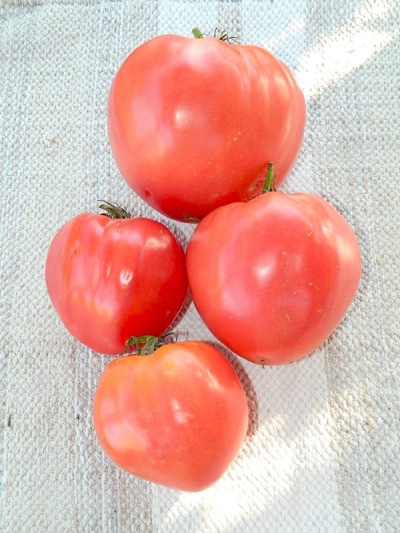
- Authors: Serbia
- Name synonyms: Kosovo
- Category: grade
- Growth type: indeterminate
- Appointment: fresh consumption, for juice
- Ripening period: late ripening
- Ripening time, days: 120-130
- Growing conditions: for greenhouses
- Bush size: tall
- Bush height, cm: 180-200
The Balkan breeding school is not very well known in our country. However, it also gives very good results. The Kosovo tomato is a vivid confirmation of this.
Description of the variety
This culture was developed by Serbian breeders. She also has a synonym - Kosovo. This is a decent indeterminate variety. Mostly in the domestic climate, it is grown in greenhouses. Outdoor cultivation is not officially described.
The bushes of such a plant are very tall. A number of examples are described when they reached 1.8-2 m. The green mass is developing quite powerfully. On the bushes of Kosovo, foliage of the usual type is formed. The culture does not demonstrate anything more botanically remarkable.
The main qualities of the fruit
Ripe berries will have a pink color. They are characterized by a large size. The usual weight is 0.3-0.5 kg. Heart-shaped berries have weak ribs. It is important to emphasize that long-term storage of the crop is impossible.
Taste characteristics
Kosovo's harvest is mainly used fresh. The main option for its processing is squeezing the juice. The pulp of the fruit is quite fleshy. It also has a delicate and juicy texture. The number of seeds inside the fruit is relatively small.
Ripening and fruiting
Kosovo is very late in arriving. You can count on harvesting in 120-130 days after the formation of green shoots. The exact time depends on both agricultural technology and the weather. But since it is impossible to influence the weather, it remains to think about how to help the plants overcome the most difficult stage of development as soon as possible.
Yield
The Kosovo tomato is very productive. The harvest per plant can be from 5 to 6.7 kg per growing season. For 1 sq. m sometimes there are up to 15 kg of berries. Much depends on the diligence of the farmers and their willingness to put in the best effort.
The timing of planting seedlings and planting in the ground
It is necessary to plant Kosovo in seedling containers during March. It is better to use not ordinary field, but carefully prepared land. The use of phytolamps helps to speed up the readiness of seedlings. The approximate time for transplanting into open ground or a greenhouse is 60 days after sowing the seeds.

Growing tomato seedlings is an extremely important process, because it largely depends on whether the gardener will be able to harvest at all. All aspects must be taken into account, from seedbed preparation to planting in the ground.
Landing scheme
A distance of 500-600 mm must be maintained between individual tomatoes. On 1 m2, 2 bushes are planted under the film. If planting occurs in an open garden, you can add 1 more plant. It is strongly discouraged to exceed these indicators, because then serious problems may arise.

Growing and caring
It is impossible to do without the formation of the tomato of Kosovo. Formation of bushes in 2 or 3 stems is recommended. Although the plant tolerates heat, it is necessary to help it in any case. Pest control also plays a big role. What specific means to choose for this protection is up to the farmers themselves.
It is necessary to water the bushes of Kosovo 3 or 4 times a week. Watering is traditionally carried out strictly at the root.
For fertilization, both organic and mineral substances are used. Good results are obtained by using Agricola. Top dressing is carried out 1 time in 12-14 days. The choice of root or foliar feeding depends on personal preference and growing conditions.
Kosovo resists well:
- phytophthora;
- verticillosis;
- fusarium wilting.
However, this does not mean that there is no need to help the plant in the fight against such pathologies. Preventive measures include the use of the proven Fitosporin-M. From natural insect repellents, the following are perfect:
- infusions of bitter herbs;
- decoction of onion husks;
- ash aqueous solution;
- water infusion of garlic.
For the rest, the cultivation of a tomato in Kosovo does not have any special nuances. For this variety, you need to use almost the same agricultural techniques as for other crops. In August, the top of the bushes is pinched. This helps to enhance the development of the plant.




A plant needs different micronutrients at each stage of growth. All fertilizers can be divided into two groups: mineral and organic. Folk remedies are often used: iodine, yeast, bird droppings, eggshells.
It is important to observe the rate and period of feeding. This also applies to folk remedies and organic fertilizers.



























































































